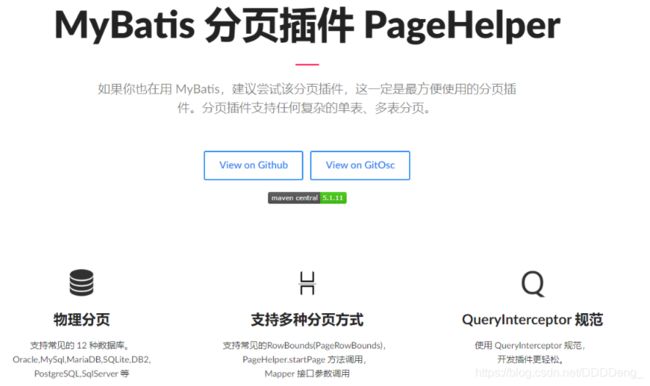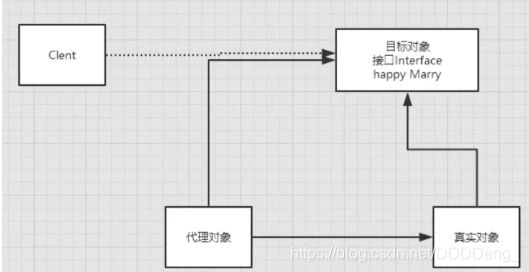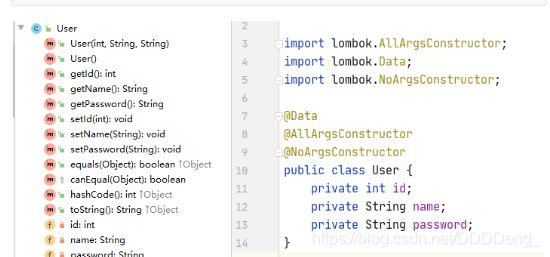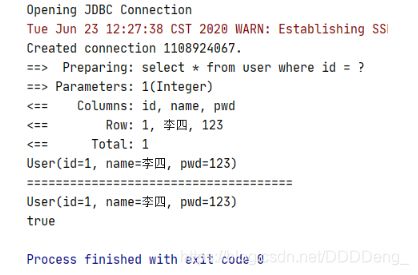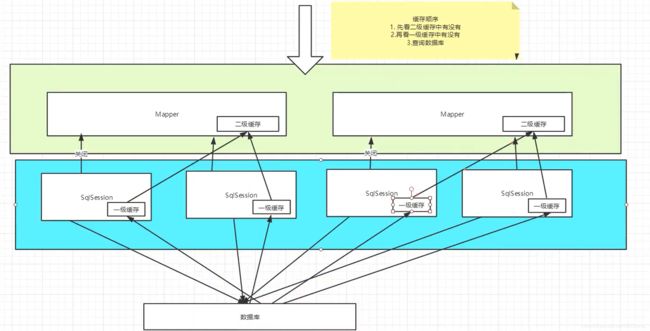MyBatis
MyBatis笔记
1、简介
1.1 什么是Mybatis
-
MyBatis 是一款优秀的持久层框架;
-
它支持自定义 SQL、存储过程以及高级映射。MyBatis 免除了几乎所有的 JDBC 代码以及设置参数和获取结果集的工作。MyBatis 可以通过简单的 XML 或注解来配置和映射原始类型、接口和 Java POJO(Plain Old Java Objects,普通老式 Java 对象)为数据库中的记录。
-
官网:https://mybatis.org/mybatis-3/zh/index.html
-
引入MyBatis
org.mybatis mybatis 3.5.2
1.2 持久化
数据持久化
- 持久化就是将程序的数据在持久状态和瞬时状态转化的过程
- 内存:断电即失
- 数据库(Jdbc),io文件持久化。
为什么要持久化?
- 有一些对象,不能让他丢掉
- 内存太贵
1.3 持久层
Dao层、Service层、Controller层
- 完成持久化工作的代码块
- 层界限十分明显
1.4 为什么需要MyBatis
- 帮助程序员将数据存入到数据库中
- 方便
- 传统的JDBC代码太复杂了,简化,框架,自动化
- 不用MyBatis也可以,技术没有高低之分,只有使用的人有高低之分
- 优点:
- 简单易学
- 灵活
- sql和代码的分离,提高了可维护性。
- 提供映射标签,支持对象与数据库的orm字段关系映射
- 提供对象关系映射标签,支持对象关系组建维护
- 提供xml标签,支持编写动态sql
- 最重要的一点:使用的人多
2、第一个Mybatis程序
思路:搭建环境 --> 导入MyBatis --> 编写代码 --> 测试
2.1 搭建环境
新建项目
- 创建一个测试数据库
- 创建一个普通的maven项目
- 删除src目录 (就可以把此工程当做父工程了,然后创建子工程)
- 导入maven依赖
<dependencies>
<dependency>
<groupId>mysqlgroupId>
<artifactId>mysql-connector-javaartifactId>
<version>8.0.12version>
dependency>
<dependency>
<groupId>org.mybatisgroupId>
<artifactId>mybatisartifactId>
<version>3.5.4version>
dependency>
<dependency>
<groupId>junitgroupId>
<artifactId>junitartifactId>
<version>4.12version>
<scope>testscope>
dependency>
dependencies>
2.2 创建一个模块
-
编写mybatis的核心配置文件
DOCTYPE configuration PUBLIC "-//mybatis.org//DTD Config 3.0//EN" "http://mybatis.org/dtd/mybatis-3-config.dtd"> <configuration> <environments default="development"> <environment id="development"> <transactionManager type="JDBC"/> <dataSource type="POOLED"> <property name="driver" value="com.mysql.cj.jdbc.Driver"/> <property name="url" value="jdbc:mysql://localhost:3306/mybatis?userSSL=true&useUnicode=true&characterEncoding=UTF-8&serverTimezone=UTC"/> <property name="username" value="root"/> <property name="password" value="root"/> dataSource> environment> environments> configuration> -
编写mybatis工具类
//sqlSessionFactory --> sqlSession public class MybatisUtils { static SqlSessionFactory sqlSessionFactory = null; static { try { //使用Mybatis第一步 :获取sqlSessionFactory对象 String resource = "mybatis-config.xml"; InputStream inputStream = Resources.getResourceAsStream(resource); sqlSessionFactory = new SqlSessionFactoryBuilder().build(inputStream); } catch (IOException e) { e.printStackTrace(); } } //既然有了 SqlSessionFactory,顾名思义,我们可以从中获得 SqlSession 的实例. // SqlSession 提供了在数据库执行 SQL 命令所需的所有方法。 public static SqlSession getSqlSession(){ return sqlSessionFactory.openSession(); } }2.3 编写代码
- 实体类
- Dao接口
public interface UserDao { public List<User> getUserList(); }- 接口实现类 (由原来的UserDaoImpl转变为一个Mapper配置文件)
DOCTYPE mapper PUBLIC "-//mybatis.org//DTD Mapper 3.0//EN" "http://mybatis.org/dtd/mybatis-3-mapper.dtd"> <mapper namespace="com.kuang.dao.UserDao"> <select id="getUserList" resultType="com.kuang.pojo.User"> select * from USER select> mapper>测试
注意点:
org.apache.ibatis.binding.BindingException: Type interface com.kuang.dao.UserDao is not known to the MapperRegistry.
MapperRegistry是什么?
核心配置文件中注册mappers
- junit测试
@Test
public void test(){
//1.获取SqlSession对象
SqlSession sqlSession = MybatisUtils.getSqlSession();
//2.执行SQL
// 方式一:getMapper
UserDao userDao = sqlSession.getMapper(UserDao.class);
List<User> userList = userDao.getUserList();
for (User user : userList) {
System.out.println(user);
}
//关闭sqlSession
sqlSession.close();
}
可能会遇到的问题:
-
配置文件没有注册
<mappers> <mapper resource="com/kuang/dao/UserMapper.xml">mapper> mappers> -
绑定接口错误
-
方法名不对
-
返回类型不对
-
Maven导出资源问题不要把想xml文件放到java目录下,要放到resource目录下
3、CURD
1、 namespace
namespace中的包名要和Dao/Mapper接口的包名一致
2、select
选择,查询语句;
-
id:就是对应的namespace中的方法名;
-
resultType : Sql语句执行的返回值;
-
parameterType : 参数类型;
- 编写接口
public interface UserMapper { //查询所有用户 public List<User> getUserList(); //插入用户 public void addUser(User user); }2.编写对应的mapper中的sql语句
<insert id="addUser" parameterType="com.kuang.pojo.User"> insert into user (id,name,password) values (#{id}, #{name}, #{password}) insert>
3.测试
@Test
public void test2() {
SqlSession sqlSession = MybatisUtils.getSqlSession();
UserMapper mapper = sqlSession.getMapper(UserMapper.class);
User user = new User(3,"黑子","666");
mapper.addUser(user);
//增删改一定要提交事务
sqlSession.commit();
//关闭sqlSession
sqlSession.close();
}
注意:增删改查一定要提交事务:
sqlSession.commit();
3、 Insert
4、update
5、 Delete
6、问题分析
- 标签不要匹配错
- resource绑定mapper,需要使用路径
- 程序配置文件必须符合规范
- NullProinterExceptoin,没有注册到资源
- 输出的xml文件中存在中文乱码问题
- maven资源没有导出问题(xml没有导出)
7、万能Map
假设,我们的实体类,或者数据库中的表,字段或者参数过多,我们应该考虑使用Map!
- UserMapper接口
//用万能Map插入用户
public void addUser2(Map<String,Object> map);
2.UserMapper.xml
<insert id="addUser2" parameterType="map">
insert into user (id,name,password) values (#{userid},#{username},#{userpassword})
insert>
3.测试
@Test
public void test3(){
SqlSession sqlSession = MybatisUtils.getSqlSession();
UserMapper mapper = sqlSession.getMapper(UserMapper.class);
HashMap<String, Object> map = new HashMap<String, Object>();
map.put("userid",4);
map.put("username","王虎");
map.put("userpassword",789);
mapper.addUser2(map);
//提交事务
sqlSession.commit();
//关闭资源
sqlSession.close();
}
Map传递参数,直接在sql中取出key即可! 【parameter=“map”】
对象传递参数,直接在sql中取出对象的属性即可! 【parameter=“Object”】
只有一个基本类型参数的情况下,可以直接在sql中取到
多个参数用Map , 或者注解!
8、模糊查询
模糊查询这么写?
- Java代码执行的时候,传递通配符% %
List<User> userList = mapper.getUserLike("%李%");
2.在sql拼接中使用通配符,这样写会导致sql注入
select * from user where name like "%"#{value}"%"
4、配置解析
1. 核心配置文件
官方文档:https://mybatis.org/mybatis-3/zh/configuration.html
- mybatis-config.xml
- Mybatis的配置文件包含了会深深影响MyBatis行为的设置和属性信息。
-
configuration(配置)
- properties(属性)
- settings(设置)
- typeAliases(类型别名)
- typeHandlers(类型处理器)
- objectFactory(对象工厂)
- plugins(插件)
- environments(环境配置)
- environment(环境变量)
- transactionManager(事务管理器)
- dataSource(数据源)
- environment(环境变量)
-
databaseIdProvider(数据库厂商标识)
-
mappers(映射器)
2. 环境配置 environments
MyBatis 可以配置成适应多种环境
不过要记住:尽管可以配置多个环境,但每个 SqlSessionFactory 实例只能选择一种环境
学会使用配置多套运行环境!
MyBatis默认的事务管理器就是JDBC ,连接池:POOLED
连接池的解释:数据库连接池负责分配、管理和释放数据库连接,它允许应用程序重复使用一个现有的数据库连接,而不是再重新建立一个;释放空闲时间超过最大空闲时间的数据库连接来避免因为没有释放数据库连接而引起的数据库连接遗漏。这项技术能明显提高对数据库操作的性能。
3. 属性 properties
我们可以通过properties属性来实现引用配置文件
这些属性可以在外部进行配置,并可以进行动态替换。你既可以在典型的 Java 属性文件中配置这些属性,也可以在 properties 元素的子元素中设置。【db.poperties】
-
编写一个配置文件,注意:xml中的属性是有顺序的
db.properties
driver=com.mysql.cj.jdbc.Driver url=jdbc:mysql://localhost:3306/mybatis?userSSL=true&useUnicode=true&characterEncoding=UTF-8&serverTimezone=UTC username=root password=root -
在核心配置文件中引入
- 可以直接引入外部文件
- 可以在其中增加一些属性配置
- 如果两个文件有同一个字段,优先使用外部配置文件的
4. 类型别名 typeAliases
-
类型别名可为 Java 类型设置一个缩写名字。 它仅用于 XML 配置.
-
意在降低冗余的全限定类名书写。
<typeAliases> <typeAlias type="com.kuang.pojo.User" alias="User"/> typeAliases>也可以指定一个包,每一个在包
domain.blog中的 Java Bean,在没有注解的情况下,会使用 Bean 的首字母小写的非限定类名来作为它的别名。 比如domain.blog.Author的别名为author,;若有注解,则别名为其注解值。见下面的例子:<typeAliases> <package name="com.kuang.pojo"/> typeAliases>在实体类比较少的时候,使用第一种方式。
如果实体类十分多,建议用第二种扫描包的方式。
第一种可以自定义别名,第二种不行,如果非要改,需要在实体上增加注解。
@Alias(“author”)
public class Author {
…
}
### 5. 设置 Settings
这是 MyBatis 中极为重要的调整设置,它们会改变 MyBatis 的运行时行为。




### 6. 其他配置
- [typeHandlers(类型处理器)](https://mybatis.org/mybatis-3/zh/configuration.html#typeHandlers)
- [objectFactory(对象工厂)](https://mybatis.org/mybatis-3/zh/configuration.html#objectFactory)
- plugins 插件
- mybatis-generator-core
- mybatis-plus
- 通用mapper
### 7. 映射器 mappers
MapperRegistry:注册绑定我们的Mapper文件;
方式一:【推荐使用】
~~~xml
~~~
方式二:使用class文件绑定注册
~~~xml
~~~
**注意点:**
- 接口和他的Mapper配置文件必须同名
- 接口和他的Mapper配置文件必须在同一个包下
方式三:使用包扫描进行注入
~~~xml
~~~
**注意点:**
- 接口和他的Mapper配置文件必须同名
- 接口和他的Mapper配置文件必须在同一个包下
### 8. 作用域和生命周期
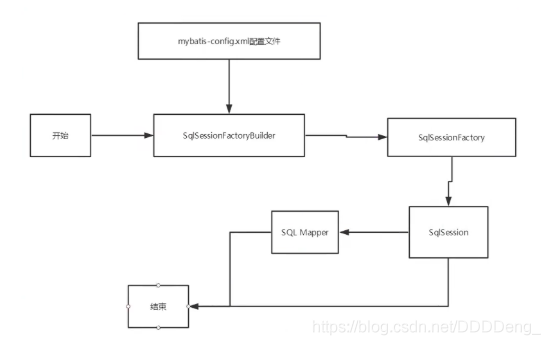
声明周期和作用域是至关重要的,因为错误的使用会导致非常严重的**并发问题**。
**SqlSessionFactoryBuilder:**
- 一旦创建了SqlSessionFactory,就不再需要它了
- 局部变量
**SqlSessionFactory:**
- 说白了就可以想象为:数据库连接池
- SqlSessionFactory一旦被创建就应该在应用的运行期间一直存在,**没有任何理由丢弃它或重新创建一个实例。**
- 因此SqlSessionFactory的最佳作用域是应用作用域(ApplocationContext)。
- 最简单的就是使用**单例模式**或静态单例模式。
**SqlSession:**
- 连接到连接池的一个请求
- SqlSession 的实例不是线程安全的,因此是不能被共享的,所以它的最佳的作用域是请求或方法作用域。
- 用完之后需要赶紧关闭,否则资源被占用!
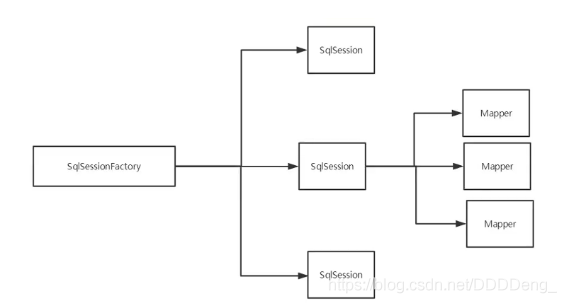
这里面的每一个mapper就代表一个具体的业务!
## 5、解决属性名和字段名不一致的问题
### 1. 问题
数据库中的字段

新建一个项目,拷贝之前的,测试实体类字段不一致的情况
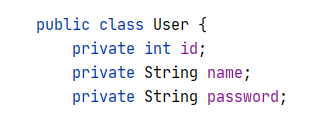
测试出现问题

~~~mysql
// select * from user where id = #{id}
// 类型处理器
// select id,name,pwd from user where id = #{id}
~~~
### 2、解决方法:
#### 1、起别名
~~~xml
~~~
#### 2. resultMap
结果集映射
> id name pwd
>
> id name password
~~~xml
~~~
- `resultMap` 元素是 MyBatis 中最重要最强大的元素。
- ResultMap 的设计思想是,对简单的语句做到零配置,对于复杂一点的语句,只需要描述语句之间的关系就行了。
- `ResultMap` 的优秀之处——你完全可以不用显式地配置它们。
- 如果这个世界总是这么简单就好了。
## 6、日志
### 6.1 日志工厂
如果一个数据库操作,出现了异常,我们需要排错,日志就是最好的助手!
曾经:sout、debug
现在:日志工厂

- SLF4J
- LOG4J 【掌握】
- LOG4J2
- JDK_LOGGING
- COMMONS_LOGGING
- STDOUT_LOGGING 【掌握】
- NO_LOGGING
在MyBatis中具体使用哪一个日志实现,在设置中设定
**STDOUT_LOGGING**
~~~xml
~~~
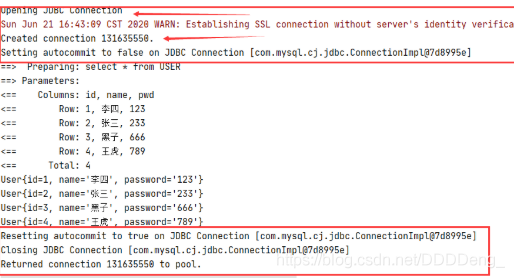
### 6.2 Log4j
什么是Log4j?
- Log4j是[Apache](https://baike.baidu.com/item/Apache/8512995)的一个开源项目,通过使用Log4j,我们可以控制日志信息输送的目的地是[控制台](https://baike.baidu.com/item/控制台/2438626)、文件、[GUI](https://baike.baidu.com/item/GUI)组件;
- 我们也可以控制每一条日志的输出格式;
- 通过定义每一条日志信息的级别,我们能够更加细致地控制日志的生成过程;
- 最令人感兴趣的就是,这些可以通过一个[配置文件](https://baike.baidu.com/item/配置文件/286550)来灵活地进行配置,而不需要修改应用的代码。
1. 先导入log4j的包
~~~xml
log4j
log4j
1.2.17
~~~
2. log4j.properties
~~~properties
#将等级为DEBUG的日志信息输出到console和file这两个目的地,console和file的定义在下面的代码
log4j.rootLogger=DEBUG,console,file
#控制台输出的相关设置
log4j.appender.console = org.apache.log4j.ConsoleAppender
log4j.appender.console.Target = System.out
log4j.appender.console.Threshold=DEBUG
log4j.appender.console.layout = org.apache.log4j.PatternLayout
log4j.appender.console.layout.ConversionPattern=[%c]-%m%n
#文件输出的相关设置
log4j.appender.file = org.apache.log4j.RollingFileAppender
log4j.appender.file.File=./log/rzp.log
log4j.appender.file.MaxFileSize=10mb
log4j.appender.file.Threshold=DEBUG
log4j.appender.file.layout=org.apache.log4j.PatternLayout
log4j.appender.file.layout.ConversionPattern=[%p][%d{yy-MM-dd}][%c]%m%n
#日志输出级别
log4j.logger.org.mybatis=DEBUG
log4j.logger.java.sql=DEBUG
log4j.logger.java.sql.Statement=DEBUG
log4j.logger.java.sql.ResultSet=DEBUG
log4j.logger.java.sq1.PreparedStatement=DEBUG
~~~
3.配置settings为log4j实现
~~~xml
~~~
4.测试运行
**Log4j简单使用**
1. 在要使用Log4j的类中,导入包 import org.apache.log4j.Logger;
2. 日志对象,参数为当前类的class对象
~~~java
Logger logger = Logger.getLogger(UserDaoTest.class);
~~~
3. 日志级别
~~~java
logger.info("info: 测试log4j");
logger.debug("debug: 测试log4j");
logger.error("error:测试log4j");
~~~
1. info
2. debug
3. error
## 7、分页
**思考:为什么分页?**
- 减少数据的处理量
### 7.1 **使用Limit分页**
~~~mysql
#每页显示pageSize条数据,从startIndex开始,如果只个给了一个参数,这个参数表示pageSize ,startIndex默认为0
SELECT * from user limit startIndex,pageSize
~~~
**使用MyBatis实现分页,核心SQL**
1. 接口
~~~java
//分页
List getUserByLimit(Map map);
~~~
2. Mapper.xml
~~~xml
~~~
3. 测试
~~~java
@Test
public void getUserByLimit(){
SqlSession sqlSession = MybatisUtils.getSqlSession();
UserMapper mapper = sqlSession.getMapper(UserMapper.class);
HashMap map = new HashMap();
map.put("startIndex",1);
map.put("pageSize",2);
List list = mapper.getUserByLimit(map);
for (User user : list) {
System.out.println(user);
}
}
~~~
### 7.2 RowBounds分页
不建议在开发中使用
不再使用SQL实现分页
1. 接口
~~~java
//分页2
List getUserByRowBounds();
~~~
2. mapper.xml
```xml
-
测试
public void getUserByRowBounds(){ SqlSession sqlSession = MybatisUtils.getSqlSession(); //RowBounds实现 RowBounds rowBounds = new RowBounds(1, 2); //通过Java代码层面实现分页 List<User> userList = sqlSession.selectList("com.kaung.dao.UserMapper.getUserByRowBounds", null, rowBounds); for (User user : userList) { System.out.println(user); } sqlSession.close(); }
7.3 分页插件
官方文档:https://pagehelper.github.io/
了解即可,万一以后公司的架构师,说要使用,你需要知道它是什么东西!
8、使用注解开发
8.1 面向接口开发
面向接口开发的目的:解耦
关于接口的理解。
接口从更深层次的理解,应是定义(规范,约束)与实现(名实分离的原则)的分离。
接口的本身反映了系统设计人员对系统的抽象理解。
接口应有两类:第一类是对一个个体的抽象,它可对应为一个抽象体(abstract class);
第二类是对一个个体某一方面的抽象,即形成一个抽象面(interface);
一个体有可能有多个抽象面。抽象体与抽象面是有区别的。
三个面向区别
- 面向对象是指,我们考虑问题时,以对象为单位,考虑它的属性和方法;
- 面向过程是指,我们考虑问题时,以一个具体的流程(事务过程)为单位,考虑它的实现;
- 接口设计与非接口设计是针对复用技术而言的,与面向对象(过程)不是一个问题,更多的体现就是对系统整体的架构;
8.2 使用注解开发
-
注解在接口上实现
@Select("select * from user") List<User> getUsers(); -
需要在核心配置文件中绑定接口
<mappers> <mapper class="com.kuang.dao.UserMapper"/> mappers> -
测试
本质:反射机制实现
底层:动态代理
MyBatis详细执行流程
8.3 注解CURD
//方法存在多个参数,所有的参数前面必须加上@Param("id")注解
@Delete("delete from user where id = ${uid}")
int deleteUser(@Param("uid") int id);
关于@Param( )注解
- 基本类型的参数或者String类型,需要加上
- 引用类型不需要加
- 如果只有一个基本类型的话,可以忽略,但是建议大家都加上
- 我们在SQL中引用的就是我们这里的@Param()中设定的属性名
#{} 和 ${}的区别:
博客地址:https://blog.csdn.net/liulang68/article/details/109783227
9、Lombok
官网:https://projectlombok.org/
博客介绍:https://blog.csdn.net/jcmj123456/article/details/109194089
Lombok项目是一个Java库,它会自动插入编辑器和构建工具中,Lombok提供了一组有用的注释,用来消除Java类中的大量样板代码。仅五个字符(@Data)就可以替换数百行代码从而产生干净,简洁且易于维护的Java类。永远不要再编写另一个 getter 或 equals 方法,使用一个注释,您的类就有一个功能齐全的构建器、自动化您的日志记录变量等等。
使用步骤:
-
在IDEA中安装Lombok插件
-
在项目中导入lombok的jar包
org.projectlombok lombok 1.18.10 -
在程序上加注解,即实体类上加注解
@Getter and @Setter @FieldNameConstants @ToString @EqualsAndHashCode @AllArgsConstructor, @RequiredArgsConstructor and @NoArgsConstructor @Log, @Log4j, @Log4j2, @Slf4j, @XSlf4j, @CommonsLog, @JBossLog, @Flogger, @CustomLog @Data //生成无参构造、get() set() toString、hashcode、equals @Builder @SuperBuilder @Singular @Delegate @Value @Accessors @Wither @With @SneakyThrows @val说明:
@Data @AllArgsConstructor @NoArgsConstructor public class User { private int id; private String name; private String password; }
10、多对一处理
多个学生一个老师;
alter table student ADD CONSTRAINT fk_tid foreign key (tid) references teacher(id)
1. 测试环境搭建
- 导入lombok
- 新建实体类Teacher,Student
- 建立Mapper接口
- 建立Mapper.xml文件
- 在核心配置文件中绑定注册我们的Mapper接口或者文件 【方式很多,随心选】
- 测试查询是否能够成功
2. 按照查询嵌套处理
<select id="getStudent" resultMap="StudentTeacher">
select * from student
select>
<resultMap id="StudentTeacher" type="student">
<result property="id" column="id"/>
<result property="name" column="name"/>
<association property="teacher" column="tid" javaType="teacher" select="getTeacher"/>
resultMap>
<select id="getTeacher" resultType="teacher">
select * from teacher where id = #{id}
select>
3.按照结果嵌套处理
<select id="getStudent2" resultMap="StudentTeacher2">
select s.id sid , s.name sname, t.name tname
from student s,teacher t
where s.tid=t.id
select>
<resultMap id="StudentTeacher2" type="student">
<result property="id" column="sid"/>
<result property="name" column="sname"/>
<association property="teacher" javaType="teacher">
<result property="name" column="tname">result>
association>
resultMap>
回顾Mysql多对一查询方式:
- 子查询 (按照查询嵌套)
- 联表查询 (按照结果嵌套)
11、一对多处理
一个老师多个学生;
对于老师而言,就是一对多的关系;
1. 环境搭建
实体类
@Data
public class Student {
private int id;
private String name;
private int tid;
}
@Data
public class Teacher {
private int id;
private String name;
//一个老师拥有多个学生
private List<Student> students;
}
2. 按照结果嵌套嵌套处理
<select id="getTeacher" resultMap="StudentTeacher">
SELECT s.id sid, s.name sname,t.name tname,t.id tid FROM student s, teacher t
WHERE s.tid = t.id AND tid = #{tid}
select>
<resultMap id="StudentTeacher" type="Teacher">
<result property="id" column="tid"/>
<result property="name" column="tname"/>
<collection property="students" ofType="Student">
<result property="id" column="sid"/>
<result property="name" column="sname"/>
<result property="tid" column="tid"/>
collection>
resultMap>
小结
- 关联 - association 【多对一】
- 集合 - collection 【一对多】
- javaType & ofType
- JavaType用来指定实体类中的类型
- ofType用来指定映射到List或者集合中的pojo类型,泛型中的约束类型
注意点:
- 保证SQL的可读性,尽量保证通俗易懂
- 注意一对多和多对一,属性名和字段的问题
- 如果问题不好排查错误,可以使用日志,建议使用Log4j
面试高频
- Mysql引擎
- InnoDB底层原理
- 索引
- 索引优化
12、动态SQL
什么是动态SQL:动态SQL就是根据不同的条件生成不同的SQL语句
所谓的动态SQL,本质上还是SQL语句,只是我们可以在SQL层面,去执行一个逻辑代码
动态 SQL 是 MyBatis 的强大特性之一。如果你使用过 JDBC 或其它类似的框架,你应该能理解根据不同条件拼接 SQL 语句有多痛苦,例如拼接时要确保不能忘记添加必要的空格,还要注意去掉列表最后一个列名的逗号。利用动态 SQL,可以彻底摆脱这种痛苦。
搭建环境
CREATE TABLE `mybatis`.`blog` (
`id` int(10) NOT NULL AUTO_INCREMENT COMMENT '博客id',
`title` varchar(30) NOT NULL COMMENT '博客标题',
`author` varchar(30) NOT NULL COMMENT '博客作者',
`create_time` datetime(0) NOT NULL COMMENT '创建时间',
`views` int(30) NOT NULL COMMENT '浏览量',
PRIMARY KEY (`id`)
)
创建一个基础工程
-
导包
-
编写配置文件
-
编写实体类
@Data public class Blog { private int id; private String title; private String author; private Date createTime;// 属性名和字段名不一致 private int views; } -
编写实体类对应Mapper接口和Mapper.xml文件
IF
choose (when, otherwise)
有时候,我们不想使用所有的条件,而只是想从多个条件中选择一个使用。针对这种情况,MyBatis 提供了 choose 元素,它有点像 Java 中的 switch 语句。还是上面的例子,但是策略变为:传入了 “title” 就按 “title” 查找,传入了 “author” 就按 “author” 查找的情形。若两者都没有传入,就返回标记为 featured 的 BLOG(这可能是管理员认为,与其返回大量的无意义随机 Blog,还不如返回一些由管理员精选的 Blog)。
<select id="findActiveBlogLike"
resultType="Blog">
SELECT * FROM BLOG WHERE state = ‘ACTIVE’
<choose>
<when test="title != null">
AND title like #{title}
when>
<when test="author != null and author.name != null">
AND author_name like #{author.name}
when>
<otherwise>
AND featured = 1
otherwise>
choose>
select>
set
更新语句的时候使用,set 元素可以用于动态包含需要更新的列,忽略其它不更新的列,set 元素会动态地在行首插入 SET 关键字,并会删掉额外的逗号(这些逗号是在使用条件语句给列赋值时引入的)。
<update id="updateAuthorIfNecessary">
update Author
<set>
<if test="username != null">username=#{username},if>
<if test="password != null">password=#{password},if>
<if test="email != null">email=#{email},if>
<if test="bio != null">bio=#{bio}if>
set>
where id=#{id}
update>
<update id="updateAuthorIfNecessary">
update Author
<if test="username != null">username=#{username},if>
<if test="password != null">password=#{password},if>
<if test="email != null">email=#{email},if>
<if test="bio != null">bio=#{bio}if>
where id=#{id}
update>
where
where 元素只会在子元素返回任何内容的情况下才插入 “WHERE” 子句。而且,若子句的开头为 “AND” 或 “OR”,where 元素也会将它们去除。
<select id="findActiveBlogLike"
resultType="Blog">
SELECT * FROM BLOG
<where>
<if test="state != null">
state = #{state}
if>
<if test="title != null">
AND title like #{title}
if>
<if test="author != null and author.name != null">
AND author_name like #{author.name}
if>
where>
select>
trim
新增数据的时候可以使用如
insert into his_depts
<trim prefix="(" suffix=")" suffixOverrides=",">
-- 解释:prefix代表前缀,为(,suffix代表后缀为),这样成了一个()即insert into his_depts
<if test="deptsId != null">depts_id,if>
<if test="deptsName != null">depts_name,if>
<if test="deptsCode != null">depts_code,if>
<if test="deptsNum != null">depts_num,if>
<if test="deptsLeader != null">depts_leader,if>
<if test="deptsPhone != null">depts_phone,if>
<if test="status != null">status,if>
<if test="createBy != null">create_by,if>
<if test="createTime != null">create_time,if>
<if test="updateBy != null">update_by,if>
<if test="updateTime != null">update_time,if>
<if test="remark != null">remark,if>
trim>
<trim prefix="values (" suffix=")" suffixOverrides=",">
<if test="deptsId != null">#{deptsId},if>
<if test="deptsName != null">#{deptsName},if>
<if test="deptsCode != null">#{deptsCode},if>
<if test="deptsNum != null">#{deptsNum},if>
<if test="deptsLeader != null">#{deptsLeader},if>
<if test="deptsPhone != null">#{deptsPhone},if>
<if test="status != null">#{status},if>
<if test="createBy != null">#{createBy},if>
<if test="createTime != null">#{createTime},if>
<if test="updateBy != null">#{updateBy},if>
<if test="updateTime != null">#{updateTime},if>
<if test="remark != null">#{remark},if>
trim>
trim 标签用于截取并拼接,即可以在条件判断完的 SQL 语句前后,添加或者去掉指定的字符。
prefix:(添加前缀)trim标签体中是整个字符串拼串后的结果,是给拼串后的整个字符串加一个前缀
suffix:(添加后缀)suffix给拼串后的整个字符串加一个后缀
prefixOverrides:前缀覆盖: 去掉整个字符串前面多余的字符(去掉前缀)
suffixOverrides:后缀覆盖:去掉整个字符串后面多余的字符(去掉后缀)
总结:
所谓的动态SQL,本质还是SQL语句,只是我们可以在SQL层面,去执行一个逻辑代码,就是使用 if、where、set、when
SQL片段
有的时候,我们可能会将一些功能的部分抽取出来,方便复用!
-
使用SQL标签抽取公共部分可
<sql id="if-title-author"> <if test="title!=null"> title = #{title} if> <if test="author!=null"> and author = #{author} if> sql> -
在需要使用的地方使用Include标签引用即可
<select id="queryBlogIF" parameterType="map" resultType="blog"> select * from blog <where> <include refid="if-title-author">include> where> select>
注意事项:
- 最好基于单标来定义SQL片段
- 不要存在where标签
动态SQL就是在拼接SQL语句,我们只要保证SQL的正确性,按照SQL的格式,去排列组合就可以了
建议:
- 先在Mysql中写出完整的SQL,再对应的去修改成我们的动态SQL实现通用即可
13、缓存
13.1 简介
查询 : 连接数据库,耗资源
一次查询的结果,给他暂存一个可以直接取到的地方 --> 内存:缓存
我们再次查询的相同数据的时候,直接走缓存,不走数据库了
- 什么是缓存[Cache]?
- 存在内存中的临时数据
- 将用户经常查询的数据放在缓存(内存)中,用户去查询数据就不用从磁盘上(关系型数据库文件)查询,从缓存中查询,从而提高查询效率,解决了高并发系统的性能问题
- 为什么使用缓存?
- 减少和数据库的交互次数,减少系统开销,提高系统效率
- 什么样的数据可以使用缓存?
- 经常查询并且不经常改变的数据 【可以使用缓存】
13.2 MyBatis缓存
- MyBatis包含一个非常强大的查询缓存特性,它可以非常方便的定制和配置缓存,缓存可以极大的提高查询效率。
- MyBatis系统中默认定义了两级缓存:一级缓存和二级缓存
- 默认情况下,只有一级缓存开启(SqlSession级别的缓存,也称为本地缓存)
- 二级缓存需要手动开启和配置,他是基于namespace级别的缓存。
- 为了提高可扩展性,MyBatis定义了缓存接口Cache。我们可以通过实现Cache接口来定义二级缓存。
13.3 一级缓存
- 一级缓存也叫本地缓存:SqlSession
- 与数据库同一次会话期间查询到的数据会放在本地缓存中
- 以后如果需要获取相同的数据,直接从缓存中拿,没必要再去查询数据库
测试步骤:
-
开启日志
-
测试在一个Session中查询两次记录
@Test public void test1() { SqlSession sqlSession = MybatisUtils.getSqlSession(); UserMapper mapper = sqlSession.getMapper(UserMapper.class); User user = mapper.getUserById(1); System.out.println(user); System.out.println("====================================="); User user2 = mapper.getUserById(1); System.out.println(user2 == user); } -
查看日志输出
缓存失效的情况:
- 查询不同的东西
- 增删改操作,可能会改变原来的数据,所以必定会刷新缓存
- 查询不同的Mapper.xml
- 手动清理缓存
sqlSession.clearCache();
小结:一级缓存默认是默认开启的,只在一次SqlSession中有效,也就是拿到连接到关闭连接这个区间端!一级缓存就是一个map。
13.4 二级缓存
- 二级缓存也叫全局缓存,一级缓存作用域太低了,所以诞生了二级缓存
- 基于namespace级别的缓存,一个名称空间,对应一个二级缓存
- 工作机制
- 一个会话查询一条数据,这个数据就会被放在当前会话的一级缓存中
- 如果会话关闭了,这个会员对应的一级缓存就没了;但是我们想要的是,会话关闭了,一级缓存中的数据被保存到二级缓存中
- 新的会话查询信息,就可以从二级缓存中获取内容
- 不同的mapper查询出的数据会放在自己对应的缓存(map)中
一级缓存开启(SqlSession级别的缓存,也称为本地缓存)
- 二级缓存需要手动开启和配置,他是基于namespace级别的缓存。
- 为了提高可扩展性,MyBatis定义了缓存接口Cache。我们可以通过实现Cache接口来定义二级缓存。
步骤:
-
开启全局缓存
<setting name="cacheEnabled" value="true"/> -
在Mapper.xml中使用缓存
<cache eviction="FIFO" flushInterval="60000" size="512" readOnly="true"/>这种更高级的配置创建了一个每 60 秒刷新一次的 FIFO 缓存,最多存储 512 个对结果对象或列表的引用,并且返回的对象被认为是只读的,因此修改它们可能会导致不同线程中的调用者之间发生冲突。
-
测试
- 问题:我们需要将实体类序列化,否则就会报错
小结:
- 只要开启了二级缓存,在同一个Mapper下就有效
- 所有的数据都会放在一级缓存中
- 只有当前会话提交,或者关闭的时候,才会提交到二级缓存中
13.5 缓存原理
注意:
- 只有查询才有缓存,根据数据是否需要缓存(修改是否频繁选择是否开启)useCache=“true”
<select id="getUserById" resultType="user" useCache="true">
select * from user where id = #{id}
select>
13.6 自定义缓存-ehcache
Ehcache是一种广泛使用的开源Java分布式缓存。主要面向通用缓存
-
导包
org.mybatis.caches mybatis-ehcache 1.2.1 -
在mapper中指定使用我们的ehcache缓存实现
<cache type="org.mybatis.caches.ehcache.EhcacheCache"/>
话关闭了,这个会员对应的一级缓存就没了;但是我们想要的是,会话关闭了,一级缓存中的数据被保存到二级缓存中
- 新的会话查询信息,就可以从二级缓存中获取内容
- 不同的mapper查询出的数据会放在自己对应的缓存(map)中
一级缓存开启(SqlSession级别的缓存,也称为本地缓存)
- 二级缓存需要手动开启和配置,他是基于namespace级别的缓存。
- 为了提高可扩展性,MyBatis定义了缓存接口Cache。我们可以通过实现Cache接口来定义二级缓存。
步骤:
-
开启全局缓存
<setting name="cacheEnabled" value="true"/> -
在Mapper.xml中使用缓存
<cache eviction="FIFO" flushInterval="60000" size="512" readOnly="true"/>这种更高级的配置创建了一个每 60 秒刷新一次的 FIFO 缓存,最多存储 512 个对结果对象或列表的引用,并且返回的对象被认为是只读的,因此修改它们可能会导致不同线程中的调用者之间发生冲突。
-
测试
- 问题:我们需要将实体类序列化,否则就会报错
小结:
- 只要开启了二级缓存,在同一个Mapper下就有效
- 所有的数据都会放在一级缓存中
- 只有当前会话提交,或者关闭的时候,才会提交到二级缓存中
13.5 缓存原理
[外链图片转存中…(img-kjCPI05Y-1645340878821)]
注意:
- 只有查询才有缓存,根据数据是否需要缓存(修改是否频繁选择是否开启)useCache=“true”
<select id="getUserById" resultType="user" useCache="true">
select * from user where id = #{id}
select>
13.6 自定义缓存-ehcache
Ehcache是一种广泛使用的开源Java分布式缓存。主要面向通用缓存
-
导包
org.mybatis.caches mybatis-ehcache 1.2.1 -
在mapper中指定使用我们的ehcache缓存实现
<cache type="org.mybatis.caches.ehcache.EhcacheCache"/>

